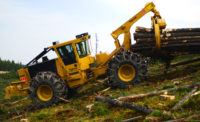When Dennis Kubica founded Kubica Corp. 20 years ago, he had an electrical engineering degree from the University of Michigan-Dearborn—and plenty of real world experience as an engineer, a research and development specialist, and a project manager for ABB, General Motors and Motor City Electric. He also envisioned his systems engineering company helping large and small manufacturers overcome their toughest challenges.
Since then, Kubica Corp. has designed and managed complex engineering projects, and developed operational technologies for manufacturers in a wide range of industries. The company’s areas of expertise include mechanical engineering, systems and robotics integration, conveyor systems and controls, paint systems and artificial intelligence.
In 2013, Kubica Corp. helped Deere-Hitachi Construction Machinery Corp. better track the work-in-process (WIP) of midsize construction excavators at its facility in Kernersville, NC. Kubica integrated and installed a tracking system that uses radio frequency identification (RFID) tags to identify, in real time, where each excavator is located during assembly. The system also collects historical data for efficiency upgrades.
John Deere and Hitachi opened the plant in 1988 as a joint venture. Both brands of excavators are made onsite, and the two companies take turns managing the facility during alternating three-year periods.
For 25 years, Deere-Hitachi’s workers manually recorded when an excavator left each workstation, as well as when it was removed from the assembly line for fixing or because of a detected flaw. That changed in 2013 when company management decided to implement the real-time tracking system.
The system features Wi-Fi RFID T2 tags, EX-2000b exciters, and a MobileView visibility system made by AeroScout Industrial; and Wi-Fi nodes and the Mobility Services Engine (MSE) made by Cisco Systems Inc.
Prior to assembly, workers attach a T2 tag (with a magnetic holder) to an excavator chassis and scan the bar-coded ID number printed on the tag’s front. This number is sent to MobileView to initiate tracking.
During assembly, the tagged chassis moves between several workstations and through 40 choke points. An exciter and node are located at each choke point.
When the chassis enters a choke point, the exciter transmits a low-frequency (125 kilohertz) signal with ID number to the tag. It, in turn, transmits both the tag’s and the exciter’s number to the node.
The MSE uses tag data received by the node to triangulate a tag’s location. MSE then forwards this data to MobileView, which records the location and uploads it to the plant’s information management system.
Should the excavator need to be taken off the assembly line for any reason, the node continues to receive tag transmissions. Once the excavator is fully assembled, its tag is scanned one final time before being removed. The excavator is now ready for shipment.
“We have been able to improve line balance and adjust work content by studying RFID data for each model,” says Brian Goins, manufacturing engineer for Deere-Hitachi. “The system enables us to track machine cycle time, stations and technician performance.”
For more information on RFID tags and other tracking-system components, call 888-925-5570 or visit www.aeroscout.com/industrial.



